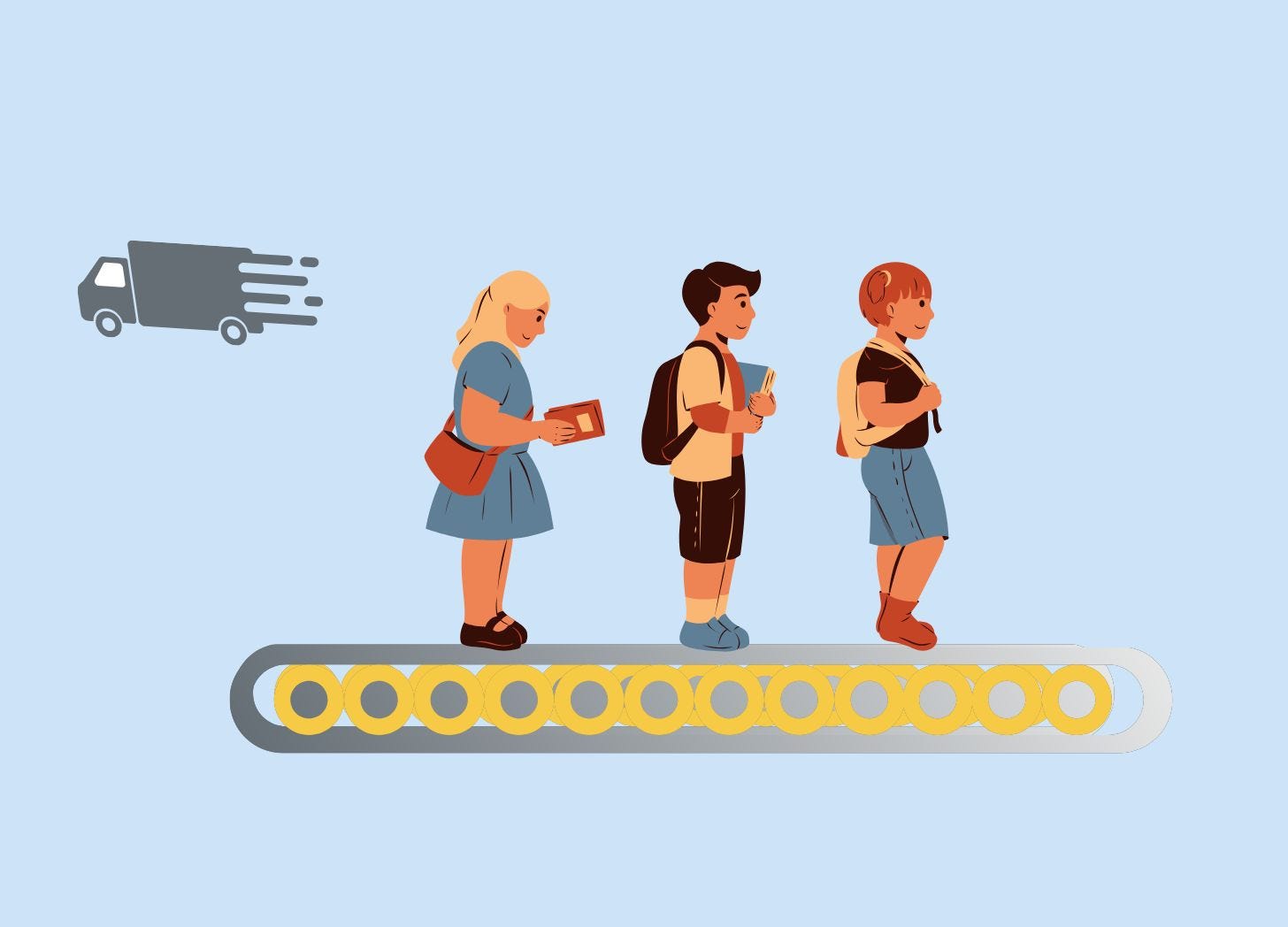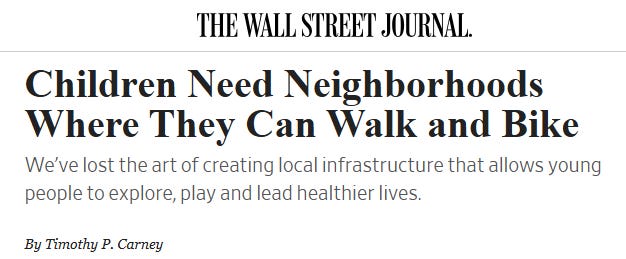The dehumanizing school car line
America’s morning ritual is treating kids like packages instead of people
Every weekday morning, across the country, parents fall into the same routine. A line of SUVs and minivans snakes around the school. Engines idle as mothers and fathers inch forward, phones in one hand, coffee in the other. Kids sit in the back seat scrolling on their own phones, waiting their turn to be unloaded by a staff member in a reflective vest. One by one, the doors open, backpacks are lifted, and the vehicle pulls away. The factory-like process is orderly, efficient, and utterly dehumanizing.
The school drop-off ritual is a powerful curriculum, teaching kids that they are packages to be delivered and picked up, and that they require constant adult supervision.
In 1969, about 48% of children walked or biked to school. By 2009, that number had dropped to just 13% (Walk Bike to School). Today, the figure hovers around 11%, largely unchanged for a decade (Rutgers University). Even among children who live within a mile of school, walking or biking has fallen from nearly 90% in 1969 to just 35% in 2009.
The shift didn’t happen because children stopped being born with legs or because they stopped wanting independence.
Schools were moved to the edges of town, often on cheap land surrounded by parking lots and wide arterial roads.
Roads were engineered to maximize long-distance automobile throughput and minimize short-distance walking and cycling.
Parents were persuaded that it was unsafe to let kids walk or bike, even though most child fatalities happen while they are passengers in vehicles.
Line up, inch forward, unload. It looks like logistics management because it is logistics management. We have turned the beginning of a school day into a miniature supply-chain operation. This logistical worldview carries profound health consequences.
Physical health: Walking and biking to school once provided children with reliable daily exercise. Today, U.S. teenagers walk about five miles less per week than teens did in the 1990s (Wall Street Journal), and rates of childhood obesity have tripled since the 1970s (CDC).
Mental health: Independent mobility builds confidence. A child who can walk to school learns to navigate space, manage risk, and take pride in independence. A child chauffeured twice a day learns dependence, passivity, and helplessness.
Safety paradox: Parents believe driving is a safe way to get around, but in 2023 alone, an average of three children were killed and another 442 injured every day in traffic crashes (NHTSA).
Packages don’t talk back, don’t take detours, don’t linger to climb a tree, or stop to pet a dog, or notice the smell of honeysuckle on the way to class. Car dependency trains kids to be passive, dependent, cogs in a machine. The irony is that the very efficiency parents crave—faster lines and predictable behavior—increases congestion, frustration, and risk to everyone on the roads.
We don’t need a time machine in order to reintroduce childhood independence to our culture:
Walking school buses are groups of kids walking together with one or two adults—offer safety in numbers while teaching kids independence.
Bike buses or bike trains do the same for cycling, helping normalize two-wheeled commutes for kids.
School siting reform could re-anchor schools back in neighborhoods, instead of exiling them to distant parcels accessible only by car.
The morning line is more than a nuisance, it’s a ritual of indoctrination. Every inch forward in that queue trains children to see themselves as cargo, delivered by others, rather than as capable people navigating their world.
But if we flip the script, if we give kids back some autonomy, the benefits ripple outward. Parents reclaim sanity. Communities reclaim healthier, calmer streets. And children reclaim one important thing the car line strips away: freedom.




I live within a 10 minute walk of an elementary school. Every one of my neighbors with children that attend it drive their kids by car and pick them up by car instead of walking 5-10 minutes. Schools during drop off and pickup also make my short list for the most dangerous places to be a pedestrian or cyclist. Followed closely by mega churches on a Sunday morning and Amazon warehouses during a shift change.
During 1969, the year cited in your article, the 8-year-old me walked to school - just a short walk up a short but steep hill in a single-family neighborhood in San Francisco proper. Many people in America today have been brainwashed by the industrial complex of big oil and automotive businesses via the media that the streets are unsafe for children. Hence the disreputable or even criminal reputation attached to parents who allow their kids to go places on their own. The streets are no more unsafe now than they were in the 1960s when kids were just as exposed to bad people if not more so than they are today. Great article, Andy. Walkable schools should rise to a higher priority in the USA, as they have started to in New York City where a few school streets have been made kid-friendly after new policies were initiated there.